ASUS G73Jw: Out with the Old, In with the New
by Jarred Walton on November 3, 2010 12:33 AM ESTASUS G73Jw: Battery Life, Noise, Heat, and the LCD
So we’ve got the same chassis, a CPU that’s the same power spec, but a different GPU. We mentioned in the past that it appears AMD could do more to tweak the 5800 mobile parts for better battery life. Without the ability to retest notebooks months later (i.e. with the latest driver updates), all we have to go on are previous results. Battery life ends up being the one area where the G73Jw is clearly superior to the G73Jh.
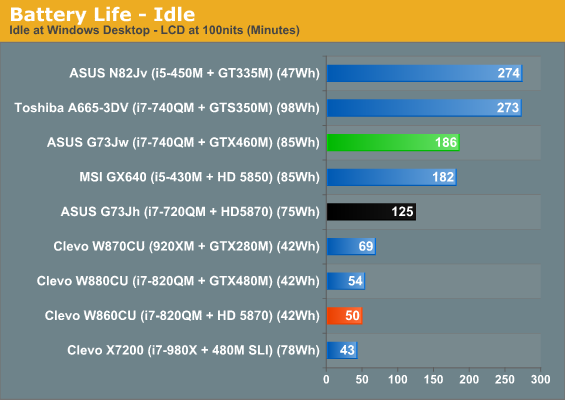
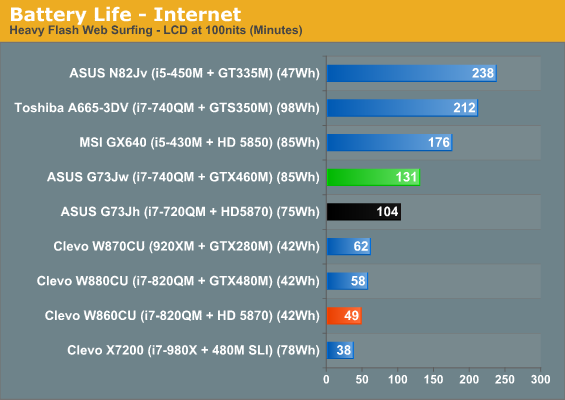
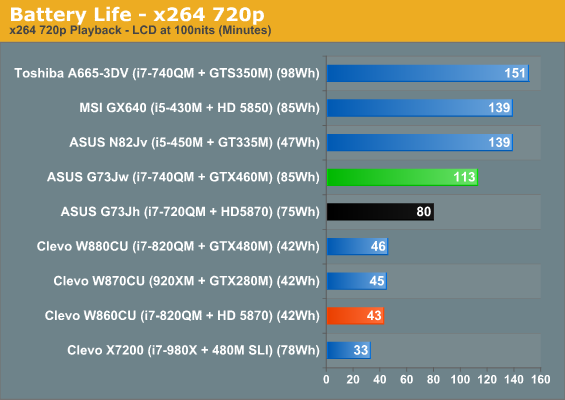
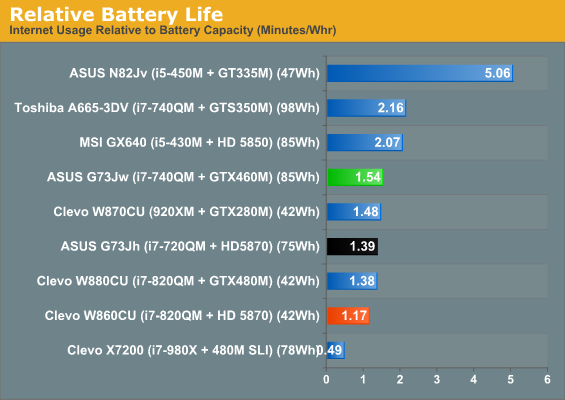
Idle battery life improves by 49%, Internet battery life is up 26%, and x264 playback is up 41%. HWMonitor even reports a wear level of 5-6% on the battery, despite over ten charge/discharge cycles, so potentially you could see even better results. However you slice it, the GTX 460M looks to be far better at idle power use than the 5870—for that matter, even the GTX 480M competes well with the HD 5870. Obviously you’re not going to buy any of the gaming notebooks as an all-day mobile solution, but it’s nice to at least get two to three hours if you need it.
If you’re interested in gaming on the battery, we also need to offer a word of caution. While we still got an hour of battery life looping 3DMark06, performance was one-third to one-fourth the speed we measured on AC power. In other words, unplug the G73Jw and the 460M suddenly starts performing like a GT 320M. That’s with the system using the highest performance options in the power settings we could select. Whether the low performance is necessary because of lack of available power from the battery, or if it’s simply a case of NVIDIA/ASUS hindering performance in order to improve battery life, unplugged the G73Jw is not going to be a gaming powerhouse.
Again we have HWmonitor reporting up to 54W of power use by a Clarksfield CPU, which is the TDP of the Extreme versions rather than the standard models. Minimum power draw for the 740QM is a massive 14W—more than some laptops use for everything at idle. Maximum CPU and GPU temperatures are very good, again highlighting how effective the G73 design is. We’re still curious as to why it’s only a 460M in the chassis, as it appears capable of handling more. Then again, perhaps it’s the power constraints rather than cooling that prevents ASUS from using something faster—and ultimately, even the mighty 480M only looks to be about 15% faster than the 460M. All things considered, the 460M looks like a good choice for the G73Jw; we’re just not convinced it’s dramatically superior to the HD 5870 in the previous model, outside of better idle power use.
The LCD: Nothing New Here
We’re not going to show detailed results for the LCD, since we’ve already seen this particular panel in the original G73Jh as well as the Clevo W880CU and X7200. It’s a good panel with an extremely high contrast ratio—we measured more than 1100:1! The down side is that maximum brightness is under 200nits, and in fact the G73Jw only manages 163nits. With such a low maximum white level, we had to double check to verify that the panel is even using LED backlighting, but it is; it’s just not particularly bright backlighting. Color accuracy and gamut are also good if not the absolute best we’ve seen. If you want to read more about the HannStar HSD173PUW1, you can refer to our G73Jh review or the X7200 review. We like the panel, but we’d still love to see a better color gamut and at least 300nits maximum brightness.


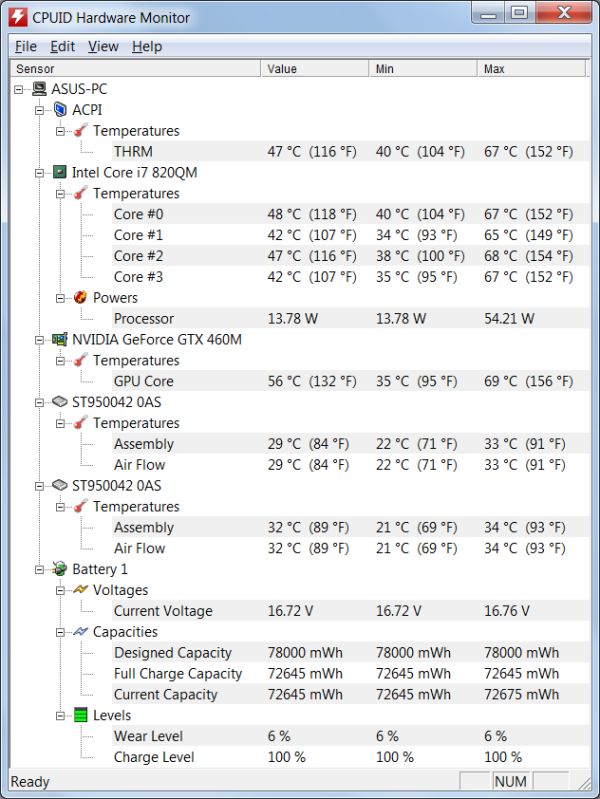








53 Comments
View All Comments
james.jwb - Wednesday, November 3, 2010 - link
Asus Asus Asus, could we please have a few different laptops maybe?hybrid2d4x4 - Wednesday, November 3, 2010 - link
Actually, I wouldn't mind one more Asus review in the near future that I think was hinted at about a month ago in the 13" MBP as a windows laptop article- the UL80JT (or UL30) with the 330UM cpu. I'd really like to see how the battery life from the new CULVs compares to the old and vs the regular voltage core 2010 ones in a machine built by people that know how to integrate/tune the hardware for good battery life. I hope that that's still on the way...MikeMurphy - Wednesday, November 3, 2010 - link
Asus has stalled in a big way. We have too many choices of laptops all with similar problems.It seems like you either have 1366x768 resolution, or you have a laptop that looks like it should be in orbit.
Asus should be taking some pointers from the Vaio Z specs.
Penti - Wednesday, November 3, 2010 - link
ASUS should also pickup a business lineup.They have a Vaio style premium line though. Like the N-series. What they lack is high-res screens.
Sony has lots of models, what Asus needs is a better commitment to making laptops.
moep - Wednesday, November 3, 2010 - link
I’m looking for a new gaming laptop right now and all I really care about is maximum performance.Judging by your review, the G73JH with the updated 740QM should be faster in most games and it is a lot cheaper over here to boot, so I could throw in a small SSD as a boot drive at no additional cost.
Did you notice an improvement in build quality on the JW overall?
Right now I really don’t see a reason to go with the updated models, unless Nvidia releases a new driver that suddenly gives the 460M a 20% performance boost.
JarredWalton - Wednesday, November 3, 2010 - link
As far as I can tell, build quality is identical. If they're the same price, I could go either way, but if you can get the JH for substantially less money and the only difference is the GPU and lack of USB3, there's no reason to pay more for the JW. I figure USB3 is worth about $40, so the US pricing right now is fine, but if the difference were more like $100+ then go with the cheaper model.Aikouka - Wednesday, November 3, 2010 - link
One thing to consider is that there are a few different variations of the JH model, although last I looked, I only saw the A2 around. The thing is, I have a friend with the A1 version, and he had a hell of a time trying to find a drive caddy for the second drive bay, since the A1 only came with 1 HDD and therefore only one caddy. The A2 has 2 HDDs by default (similar to the JW) and should have two caddies.Since the user was talking about throwing a SSD into the laptop, I think he'd really want to make sure he got an A2 so he wouldn't have to worry about finding a caddy. Although, finding a caddy might also be significantly easier now... since I don't actually own the laptop, I'm not 100% sure :P.
TheTechnophile - Thursday, November 4, 2010 - link
There have been a few issues with the JHs. The problems always come out after the "newness" of a system has faded away. You can check out the Xotic PC forums as a good place to get info on these systems.In particular some of the problems which the JH has, but apparently the JW does not are:
GSOD (BIOS update seemed to have fixed this.... I think.)
Missing keystrokes ( a particularly problematic one with the JH)
Although good tempsin the JH, the JW is MUCH cooler, thereby increasing component life.
On both of them, one of the things that make me cringe is that they use double-sided sticky tape to attach the keyboard. The keyboard is also comprised of a thin aluminium backing, extremely easy, if not impossible not to, bend and crease when removing to get into the machine.
I think the JW has learned from some of the mistakes of the JH. Both are good machines, but go check out what really has been happening with them. Remember there are alot of people over there who love the machine...no matter how many problems it gives them.
TheTechnophile - Thursday, November 4, 2010 - link
Sorry...also forgot. They updated the backlit keyboard app as well. Now it comes on before Windows starts. Previously you had to wait to get into Windows before the application could launch to turn on backlighting. Just another nice touch they added, and learned, to the JW.Quizzical - Wednesday, November 3, 2010 - link
5 GHz memory? You sure about that? No desktop parts have hit that clock speed, even. Laptop parts tend to be clocked slower. Nvidia has been arbitrarily multiplying GDDR5 clock speeds by 2 to try to cover up the embarrassingly slow clock speeds that their GDDR5 memory controller is stuck at, so that's probably what they did here.The multiply by 2 bit makes some sense for double data rate memory, but none at all for quad data rate. Maybe they thought it would be more obvious what they were doing if they multiplied by 4.